5 Ways Snapdragon Wear 3100 Is Fixing Wear OS Watches
Google can’t fix Wear OS on its own. And that’s where Snapdragon Wear 3100 comes in.
Updated 9:56 a.m. Pacific with the name of the first smartwatch running on Qualcomm's Snapdragon Wear 3100.
Wear OS smartwatches built on Google’s platform are known for being more style-conscious than the competition. But Wear OS devices have lagged behind the Apple Watch and Samsung’s Tizen OS watches because the majority of them are built on a 2-year-old Qualcomm chip, the Snapdragon Wear 2100.

Devices are still shipping with Qualcomm’s last-gen CPU — including a few watches announced this month at IFA — but Qualcomm has been working on a new chip, the Snapdragon Wear 3100, that will finally fix some of the biggest problems we’ve had with Wear OS watches.
The first Wear OS watch built on Snapdragon Wear 3100 will be the Montblanc Summit 2, which will ship in October. Two more devices from Fossil and Louis Vuitton are launching before the holidays. Here’s what you can expect from the smartwatches with Qualcomm’s new chip baked in.
Redesigned For Wearables
Qualcomm redesigned the 3100 to be more power- and battery-efficient, with an ultra low-power co-processor that runs alongside the main processor. The co-processor can handle many minor tasks that don’t require full-blown power, including basic fitness features such as step-counting and a colorful always-on display for telling the time.

Asking a Wear OS watch’s main processor to handle those small jobs drains the battery and makes the watch more sluggish, which is a big problem I’ve had with watches running on the 2100 chip.
Sign up to get the BEST of Tom's Guide direct to your inbox.
Get instant access to breaking news, the hottest reviews, great deals and helpful tips.
The new chip makes possible a set of features that weren’t workable on past Wear OS watches, even with the improvements Google is rolling out on the software side. Matthew DeHamer, Qualcomm’s product marketing manager for wearables, said Google was heavily involved in the creation of Snapdragon Wear 3100.
MORE: Google Just Fixed One of the Biggest Problems with Wear OS Watches
“It’s been a two-year development building this co-processor,” DeHamer said. “A lot of time and engineering went into that, and a lot of work with Google. We haven’t been sitting on our laurels.”
The 3100 will enable Google to build out new features for Wear OS, while also giving smartwatch makers more control over how their devices look and how long they last on a charge.
Extended Battery Life
The 3100 enables a new traditional watch mode will let you squeeze extra life out of your Wear OS device. Some Android watches have a battery saver mode that shuts down all features except for the time. The 3100 will enable two-day battery life in full smartwatch mode, which can be extended up to a week in traditional watch mode with a custom watch face and updating information from the watch’s sensors.
If you activate traditional watch mode on a full charge, you’ll be able to get a month of battery life out of a Wear OS device.
Some Wear OS watchmakers, such as Casio and Mobvoi’s TicWatch, have developed dual-layer displays to enable a similar watch mode feature. Qualcomm’s new co-processor makes that possible without physically separating the OLED display from a more power-efficient one.
Custom Always-On Watch Faces
Many Wear OS watches are made by luxury fashion brands, such as Montblanc and Louis Vuitton, that want their smartwatches to reflect the label’s aesthetic. That’s tough to do if the watch’s screen goes dark when inactive; a black display doesn’t exactly have personality. So the 3100 enables an enhanced ambient mode, which keeps the display on at all times with support for up to 16 colors, watch face complications that update in real-time and brightness levels that automatically adjust in sunlight.
Advanced Fitness-Tracking
The new chip will also make it possible to use a Wear OS watch as a full-color touchscreen device in GPS mode for up to 15 hours, which is a major development for makers of sporty smartwatches. On average, you’d be able to get three or four hours in workout mode from a Wear OS watch running on the 2100 chip today. Qualcomm is working with a dedicated sports watch maker to showcase those new fitness features in a watch coming early next year.
Mobile Payments
Qualcomm is using a new NFC chip in its next-gen wearables processor to support more mobile payment systems.
“Each brand can decide if they want to implement NFC, but we want to make sure it becomes the default,” Qualcomm’s Matthew DeHamer said. “There’s interoperability with different mobile payment systems and transit systems.”
Outlook
Now that Google has confirmed that it won’t release its own Wear OS smartwatch this year, buyers interested in an Android watch will have to look elsewhere. With Google improving Wear OS on the software side and Qualcomm upgrading the guts to make new features possible, a better selection of devices is on the horizon.
We plan to put these new wearables to the test to see if the 3100 makes Wear OS watches worth buying.
Caitlin is a Senior editor for Gizmodo. She has also worked on Tom's Guide, Macworld, PCWorld and the Las Vegas Review-Journal. When she's not testing out the latest devices, you can find her running around the streets of Los Angeles, putting in morning miles or searching for the best tacos.
